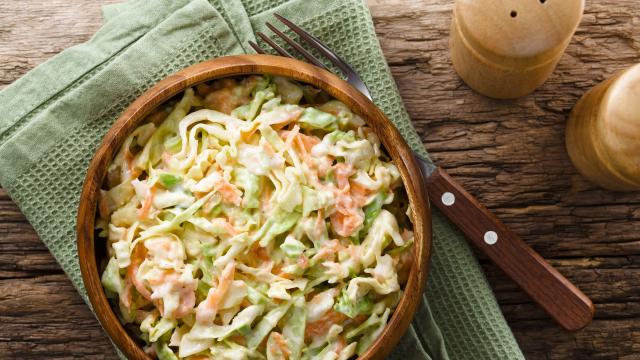I love coleslaw of all kinds. I love sweet slaw, tangy, vinegary slaw, and hot slaw that’s been dressed with a little pepper jelly. What I don’t love is watery slaw. If you’ve ever observed coleslaw that’s been sitting out for a few hours, you know what I’m talking about. The mixture of cabbage and carrots starts out cool and crunchy, but an hour or so later, you find it swimming in watered-down dressing. Luckily, you can stop the sog with a little bit of salt.
Cabbage, like most vegetables, holds a lot of water in its cellular walls. When you toss it with a dressing that contains salt and sugar (common ingredients in coleslaw dressing), the water in the cabbage flows out of the vegetable and in to the bowl, in an attempt to equalise the concentration of salt and sugar in the cabbage and dressing. This is called “osmosis,” and it’s going to happen no matter what, so you might as well harness its power and draw out a little water before dressing your slaw.
A few things happen when you salt cabbage (or any vegetable). The salt draws moisture out from the plant, which means the solutes in your dressing can’t draw it out later. The shreds also soften a little, but not too much. They retain their crunch, but lose that raw, cruciferous quality, and become pliable, but not soft. (If you want to soften cabbage, for sauerkraut or something similar, you’ll need to massage it with salt.) Removing excess moisture also concentrates the cabbage’s flavour (water dilutes, after all), leaving behind crisp, flavorful shreds that are just a little easier to chew, for a slaw that can sit out without devolving into a watery mess within the hour.
How to salt cabbage for coleslaw
Start by shredding your cabbage. I like to do this with a sharp knife or mandoline, but if you must automate it, use the slicing attachment on your food processor, not the shredding attachment. The shredding attachment (or box grater) is a lot rougher on the cellular walls of the vegetable, which can lead to mushy slaw.
Once your cabbage is prepared, toss the shreds with 1 teaspoon of fine salt per pound of cabbage, transfer it to a colander, and let it drain for a couple of hours. Rinse off the salt, and dry it completely; use a salad spinner, or gently press the cabbage between clean kitchen towels (or paper towels), repeating with fresh towels as needed.
Do not soak your cabbage in ice water
Some recipes recommend a cold soak, but you shouldn’t do this. Soaking cabbage in cold water will plump it up and make it crunchier, at least for a moment. (This is why storing lettuce with a damp paper towel keeps it feeling fresh; the moisture keeps the leaves firm and crunchy.) Unfortunately, you’re just introducing more water for the solutes in your dressing to pull out, which will result in even more water pooling at the bottom of the bowl.
Dress right before serving
The longer your cabbage sits in dressing, the more time the salt and sugar in the dressing will have to do their thing. Salting will buy you more time, but dressing just before serving adds an extra layer of protection against the sog, and the sog is the enemy of appealing cole slaw. If you need a good dressing recipe, try ours. (It’s got mayo and sour cream, and I think that’s pretty tight.)

Leave a Reply
You must be logged in to post a comment.